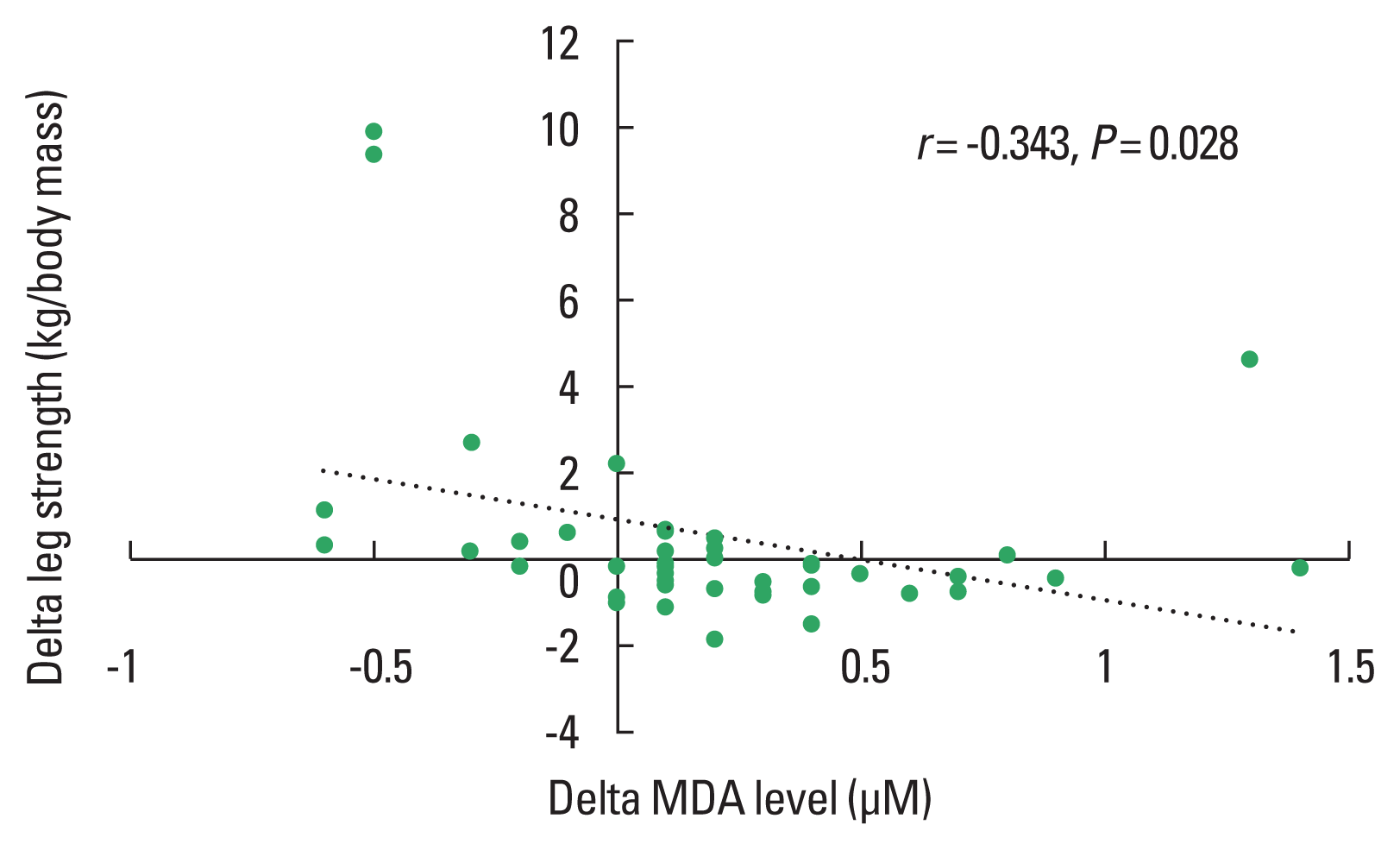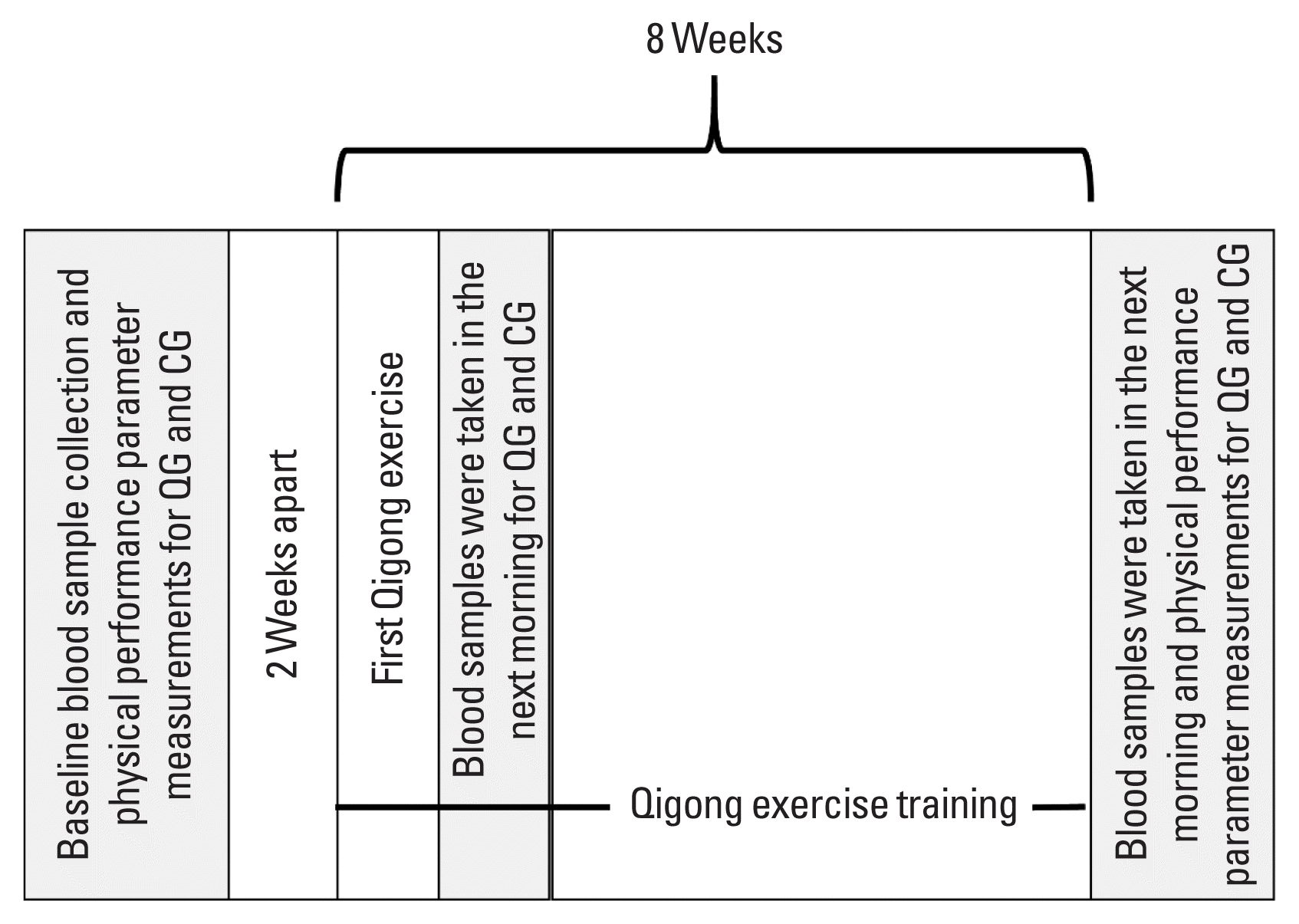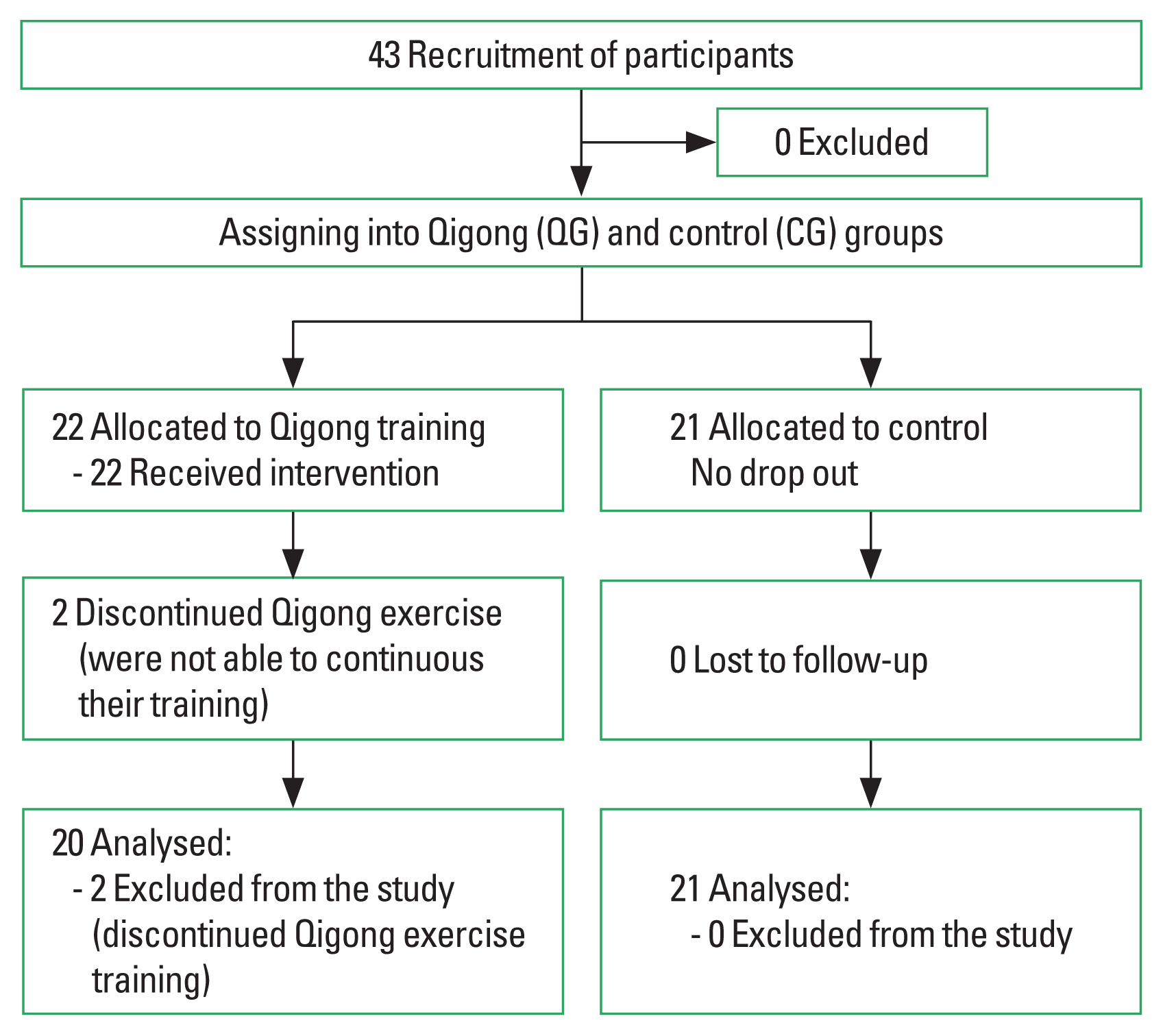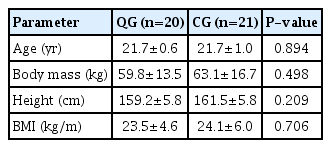Effects of Qigong exercise on muscle strengths and oxidative stress/antioxidant responses in young sedentary females: a quasi-experimental study
Article information
Abstract
Regular exercise is associated with the production of small amounts of oxidative stress which might promote individual antioxidant capacity contributing to favorable training effects potentially interrelated with skeletal muscle strength. Therefore, the present study was aimed at evaluating effects of an 8-week Qigong exercise training on muscle strengths associated with responses of oxidative stress and antioxidants in young sedentary females. A total of 41 sedentary women were allocated to the Qigong exercise group (QG, N=20) or to the control group (CG, N=21). After 8 weeks of Qigong training, back and leg strength was significantly improved compared to baseline and the CG (P<0.05). Plasma oxidative stress levels were reduced and total antioxidant capacity was enhanced in the QG compared to the CG (P<0.05). Correlation analyses revealed that improvements in muscle strength (including both groups) were associated with changes in the levels of oxidative stress (reduction) and antioxidants (elevation). The presented findings indicate that strength training effects seem at least partly to be interrelated with alterations of the oxidant-antioxidant balance generated by the 8-week Qigong training in young sedentary females.
INTRODUCTION
Qigong exercise training was shown to elicit beneficial effects on physical performance in women (Sakata et al., 2008). This type of exercise is a traditional Chinese exercise, consisting of isometric, aerobic, isotonic, relaxing, and meditative movements (Larkey et al., 2009; Tsang et al., 2003). It may result in improved trunk strength and movement abilities in the elderly (Wolf et al., 1996). Additionally, it was demonstrated to improve quality of life in patients suffering from chronic illnesses, i.e., diabetes mellitus, dyslipidemia, and cancer (Cavegn and Riskowski, 2015; Chuang et al., 2017; Pan et al., 2016). For instance, Qigong exercise enhanced balance and fitness as well as somatosensation in diabetes mellitus patients (Cavegn and Riskowski, 2015), decreased fatigue, improved sleep quality along with increased white blood cell counts and hemoglobin levels in non-Hodgkin lymphoma patients (Chuang et al., 2017). Moreover, practicing such exercises may also impact on lipid metabolism, but information on most appropriate intensity and duration is still lacking (Pan et al., 2016). Endurance exercise is associated with enhanced oxygen consumption also resulting in elevated production of reactive oxygen species (ROS) (Alessio, 1993).
On the other hand, current studies show that regular exercise training will promote upregulation of the antioxidant capacity (Clarkson and Thompson, 2000; Elosua et al., 2003; Evelo et al., 1992). Similar results were demonstrated with the use of other traditional Chinese exercises. With respect to previous studies, Tai Chi and Qigong effects have mainly been evaluated in middle aged and older people (Goon et al., 2009; Li et al., 2001; Thornton et al., 2004; Wolf et al., 1996; Wolfson et al., 1996). The assumption that the outcomes of one population could be transferred to another population through the same intervention may not hold true. For instance, Tai Chi or Qigong exercise affects more beneficially cardiovascular performance of older than younger adults (Zhuo et al., 1984). Gender differences may also occur with regard to the motivation for exercise. Gordon-Larsen et al. (2004) reported less physical activity in females than males and sedentary behavior trends in adolescence will continue to persist into adulthood. Qigong exercise training for 4 weeks improved balance in young women (González López-Arza et al., 2013). Huang et al. (2014) demonstrated that Tai Chi training for 8 weeks reduced oxidative stress levels in young sedentary females, however, the lack of control group limits firm conclusions. There are several studies suggesting improved antioxidant capacity and anti-inflammatory responses following Tai Chi training (Mendoza-Nunez et al., 2014; Rosado-Perez et al., 2013). It is likely that the small amount of ROS generation from moderate-intensity exercise stimulates signaling pathways contributing to upregulation of antioxidant enzymes (Gomez-Cabrera et al., 2008) and the improved force generation (Andrade et al., 2001).
The relationship between changes in oxidative stress/total antioxidant capacity (TAC) and skeletal muscle strength resulting from regular Qigong training has been rarely studied particularly in the population of young sedentary females. Thus, the present study was aimed to determine the impact of Qigong training over 8 weeks on those parameters in young and untrained women. We hypothesized that Qigong training will modulate the balance between oxidative stress and TAC potentially associated with the improvement in muscle strength of the back and legs and trunk flexibility.
MATERIALS AND METHODS
Participants
Voluntary young female participants were enrolled from students of Burapha University, Bangsean, Chonburi province, Thailand. Inclusion criteria were an age range between 21 to 23 years, being nonsmoker, not drinking alcohol, not being physically active on a regular basis (more than once per month), and not taking antioxidant supplementation. Physical activity records were used to assess sedentary lifestyle (Tremblay et al., 2017). Participants of the CG were advised to continue their lifestyle throughout the study period. Exclusion criteria were any disease that would be associated with a health risk when performing the Qigong training. The PAR-Q was used to assess a potential health risk associated with exercise (American College of Sports Medicine, 2018).
Due to the relatively long intervention period, a quasi-experimental design was employed for allocating 43 female undergraduate students to the Qigong training group (QG, N=22) and the control group (CG, N=21). The study was reviewed and approved by Burapha University Human Institutional Review Board (021/2563) and Thai Clinical Trial Registry (TCTR20200805003). The work was done in accordance with the appropriate institutional review body and carried out with the ethical standards set forth in the Helsinki Declaration of 1975.
Qigong exercise intervention and blood sample collection
Qigong exercise consisted of gentle, concentrated movements together with breathing, relaxation, and carefulness by the use of 18 typical movements modified according to Taiji Qigong by Robinson (2017) and Ladawan et al. (2017). The QG was leaded by an instructor who continued Qigong exercise training for 8 years. The Qigong exercise training started with a 2-min warm-up by stretching, followed by the 18 movements of Qigong exercise for 60 min and was finished with 2 min of stretching for cool down. The Qigong training was performed once a day, 5 days per weeks over 8 weeks.
Blood samples were taken from antecubital veins 3 times at the same time and days for both QG and CG. Subjects were overnight fasting before the blood collections taken at around 7 a.m. Blood samples of both groups were collected at baseline (PRE), and the next morning after finishing the first day of exercise (or observation in the CG), and were defined as ACUTE. The 3rd determination was done the next morning after completing 8 weeks of Qigong exercise training (or 8 weeks of observation in the CG) defined as POST (Fig. 1).
Assessment of back and leg strength
The back and leg muscles strength were assessed using an electronic dynamometer (T.K.K. 5102 Back-D, Takei Scientific Instruments Co., Tokyo, Japan). Subjects stood on the board of the dynamometer with their feet about 20–30 cm apart. For determining back strength, they grasped the grips with both hands without bending their knees, set at 30° of hip flexion then adjusted the length of the chains and gently strained the back muscle (Oh et al., 2012). The leg muscle strength was determined with subjects bended their knees about 130°–140°, while grasping the grips with both hands in stretch position. The chain was held at an appropriate knee angle. The measurement of leg strength was determined while subjects slowly but powerfully stretched the legs without using back muscle (Arslan, 2005). Two attempts were made for each test with a 1-min rest attempts. Measured values were averaged (unit in kg) and divided by the individual body mass (kg).
Assessment of trunk flexibility
The trunk flexibility was determined by use of the sit and reach test. Participants sat on the floor and placed feet against the box (Baseline 12-1085 Sit n’ Reach Trunk Flexibility Box-Standard, Fabrication Enterprises, Inc., White Plains, NY, USA) no wider than 8 inches apart with hips, back and head against a wall. Legs must be extended with back of knees touching the floor. Subjects were instructed to place one hand on top of the other and to reach as far as possible. The back of the knees must stay flat on the floor. There should be no lunging, bobbing, or forced assistance. The stretch has to be held for 1 sec (Trajkovic et al., 2020). Two attempts were used to determine the trunk flexibility and values were averaged (unit in cm).
Determination of TAC as ferric reducing antioxidant power assay
The ferric reducing antioxidant power (FRAP) assay was modified from Benzie and Strain (1996) and Frei et al. (1989), then employed into 96 well plate reader. Plasma samples were diluted into 10 times with normal saline. In our evaluations, FRAP concentrations were ranged from approximately 0 to 1,000 μM. Each reaction contained 75 μL of the FRAP color solution (12.5 mL of 300 mmol/L acetate buffer pH 3.6, 1.25 mL of 10.0 mmol/L 2,4,6-tripyridyl-s-triazine solution, 1.25 mL of 20.0 mmol/L FeCl3.6 H2O solution), and 20 μL of the samples into duplicate wells in the plate. The resulting mixture was vigorously shaken and then incubated at 25°C for 30 min and the increase in absorbance at 560 nm was measured and compared with the ferrous chloride standard and ascorbic acid as control.
Determination of catalase enzyme activity
The catalase enzyme activity (CAT) activity assay was measured using spectrophotometric determination of hydrogen peroxide (H2O2) which form stable complex with ammonium molybdate that absorbs at 405 nm (Goth, 1991). Briefly, 1 mL of substrate (65 μmol per mL H2O2 in 60 mmol/L phosphate buffer, pH 7.4) was incubated with 50 μL of serum at 37°C for 60 sec. The enzymatic reaction was stopped with 1.0 mL of 32.4 mmol/L ammonium molybdate ((NH4)6 Mo7O24·4 H2O) and the yellow complex of molybdate and hydrogen peroxide is measured at 405 nm against reagent blank. The serum CAT activity was linear up to 100 kU/L. If the CAT activity exceeded 100 kU/L, the serum should be diluted with phosphate buffer. One unit of CAT decomposes 1 μmole of hydrogen peroxide/l min under assay conditions. The CAT activities are expressed as kilo unit per liter (kU/L).
Determination of oxidative stress as malondialdehyde level
Malondialdehyde (MDA) was measured by thiobarbituric acid (TBA) reactive substance assay modified from Nielsen et al. (1997) and Tsai et al. (1993). A 1 mL of 1:2 diluted plasmas was added with 50 μL of 0.1-mM butylated hydroxyl toluene, 500 μL of 5-mM ethylenediamine tetraacetic acid (EDTA), 1 mL of 8.1% (w/v) sodium dodecyl sulfate (SDS), 1 mL of 10% (w/v) trichloroacetic acid, and 1.5 mL of 0.67% (w/v) TBA. After that the mixture was incubated at 95ºC for 30 min, then dipped into water for 5 min. Later, it was centrifuged at 3,000 rpm for 15 min at room temperature. The supernatant was transferred to a glass cuvette for detecting absorbance at 532 nm. Tetraethoxypropane was used as standard and set the concentration range between 0.25–2 μM.
Determination of blood uric acid and albumin
Blood samples were transferred to EDTA tube for blood uric acid and albumin. Then, samples were delivered on ice and immediately measured by National Healthcare system (Samitivej Chonburi Hospital). Albumin was analyzed using automated machine (Cobas Cobas c 311/501 analyzers, Roche Diagnostics GmbH, Sandhofer Strasse, Manheim, Germany). Blood uric acid was determined using the peroxide reacts in the presence of peroxidase, N-ethyl-N-(2-hydroxy-3-sulfopropyl)-3-methylaniline, and 4-aminophenazone to form a quinone-diimine dye. The intensity of the red color formed is proportional to the uric acid concentration and is determined photometrically (Cobas Cobas c 311/501 analyzers, Roche Diagnostics GmbH).
Data analysis
Data analyses were performed by using SPSS ver. 17.0 (SPSS Inc., Chicago, IL, USA). The Kolmogorov–Smirnov test was used to test normality. Normally distributed data were expressed as mean±standard deviation. Not normally distributed data are reported as median (interquartile range). The main outcomes of physical performances (back and leg strength, and trunk flexibility) for changes from PRE to POST within each group were determined using paired t-test or Wilcoxon signed-rank test as appropriated. Student t-test or Mann–Whitney U-test was performed to compare mean differences of POST minus PRE between the exercise group and the control group. Interactions (time×group) were computed using analysis of variance with repeated measurements and two factors, in which group (QG or CG) was fixed factor and training time points (PRE, ACUTE, and POST) was repeated factor. A P<0.05 was considered statistically significant.
A power calculation for sample estimation was based on leg strength with regard to the study of Song et al. (2014), comparing before to after Tai chi exercise training at 4 months. With an alpha at 0.05 and power at 0.90 using paired t-test, the sample size was 20 participants per group (G*power 3.1).
RESULTS
PRE, (ACUTE) and POST-measurements were completed by 20 participants of the QG and 21 participants of the CG. Two participants of the QG dropped out because they were not able to continue their training as indicated in the flow diagram demonstrating the study progress (Fig. 2). Some participants from the QG changed their exercise time from the morning to the evening. Baseline characteristics did not differ between QG and CG (Table 1).
Physical performances
Back and leg strength values were significantly improved after Qigong training (POST) and those changes were also significantly different compared to the CG (all P<0.05) (Table 2). Trunk flexibility was significantly enhanced only after Qigong training (POST) but did not differ compared to the CG (Table 2).
Plasma oxidative stress and antioxidants
Significant interaction effects (time×group) were found with regard to the MDA, albumin, and TAC levels (P<0.05) (Table 3). Compared to the QG, MDA and albumin levels were increased and TAC levels were decreased (postintervention) in the CG.
Correlation
Changes in back and leg strength from PRE to POST were negatively correlated with changes in MDA levels (r=−0.411 and −0.343, P<0.05) (Figs. 3, 4). Changes in leg strength from PRE to POST were positively correlated with changes in TAC (r=0.533, P<0.05) (Fig. 5).

Correlations between changes (delta, difference POST minus PRE) in back strength and changes (delta, difference POST minus PRE) in oxidative stress (MDA) including both the Qigong and the control group.

Correlations between changes (delta, difference POST minus PRE) in leg strength and changes (delta, difference POST minus PRE) in oxidative stress (MDA) including both the Qigong and the control group.
DISCUSSION
The main findings of the present study demonstrate improved back and leg strength in the QG compared to the CG and that alterations of the strength levels (within both groups) were negatively correlated with changes in oxidative stress and positively with antioxidant capacity. These results indicate that strength training effects may at least partly be interrelated with alterations of the oxidant-antioxidant system induced by Qigong training in young previously sedentary females.
Effects of ROS on excitation-contraction coupling were shown by Reid et al. (1993) who demonstrated that skeletal muscle bundles decreased force generation with exogenous catalase incubation and in contrast, exogenous hydrogen peroxide incubation induced increased force production. Therefore, oxidative stress, at least in low concentration, appears to be a prerequisite for beneficial training effects opposed to large level of ROS which may induce inhibition of function (Radak et al., 2005). Qigong training prevented the elevation in MDA levels and the reduction in TAC levels as observed in the CG.
The favorable effects of Qigong training on strengths are consistent with previous studies demonstrating significant improvements of knee extension strength after Tai chi training in elderly subjects (Christou et al., 2003; Lan et al., 2000; Song et al., 2014; Wolfson et al., 1996). Additionally, Hart and Tracy (2008) reported that Yoga training for 8 weeks significantly increased knee strength in young adults. The Qigong posture is similar to Tai chi where exercises are carried out in semisquat posture with slow movements and load shifting of the body. The changing sequence of concentric and eccentric contractions are primarily involving the lower extremities in closed kinetic chain exercise (Christou et al., 2003; Lan et al., 2000). Mechanisms related to improved strength and performance of skeletal muscles following resistance training include increase of muscle cross-section and changes in recruitment and firing rates of motor unit types (Carroll et al., 2001; Tracy et al., 2004). Based on our observations, changes in the oxidant-antioxidant balance may also have modified strength development due to Qigong training. The observations of elevated TAC and reduced oxidative stress and albumin levels after Qigong training are well in accordance with results from Rosado-Perez et al. (2013) and Mendoza-Nunez et al. (2014) who demonstrated that Tai Chi exercise over 6 months increased TAC, while oxidative stress (ROS) was reduced (Rosado-Perez et al., 2013). The slight decrease of albumin levels in the QG compared to the CG seems surprising. Albumin is one of the protein thiols that is abundant in plasma (Kundi et al., 2015). Gol et al. (2019) indicated that the total thiol pool that stands for antioxidant capacity is of insufficient function in sedentary people. Thus, in conditions associated with increasing oxidative stress, stimulation of the antioxidant defense and protein thiols may be not sufficiently effective in subjects with sedentary lifestyle (Gol et al., 2019; Tebay et al., 2015).
The light to moderate stimuli of Qigong exercise might induce small oxidative damage resulting in upregulation of the antioxidant systems and repair mechanism (Evans and Cannon, 1991). This is consistent with current studies suggesting that regular exercise activates antioxidant protection (McArdle and Jackson, 2000) and oxidative repair response (Sato et al., 2003; Wittwer et al., 2004). Results of the presented correlation analysis reveal a positive relationship between the Qigong training associated improvements in the antioxidant capacity and muscular strength enhancement while MDA levels were negatively related to strength development. Low concentration of hydrogen peroxide in skeletal muscle enhances Ca2+ discharge from the sarcoplasmic reticulum and force generation while large amount of hydrogen peroxide develops a reduction of force production (Andrade et al., 2001).
If confirmed in more large-scaled studies, these findings will not only have implication on the understanding of underlying mechanisms responsible for Qigong training effects but also for the appropriate use of antioxidants with exercise training for improving muscle strengths. Some limitations have to be mentioned. First, participants were not randomly assigned to the intervention or CG due to potential time constraints. However, based on their characteristics (Table 1) no differences between groups did exist. Furthermore, we did not strictly control diet during the study period but participants were asked not to change diet which, based on our observations, may have been actually followed. Nevertheless, strengths of the current study include the relatively large sample of homogenous sedentary females and the properly monitored exercise training.
In conclusion, the presented findings demonstrate improved back and leg strength in previously sedentary young females after 8 weeks of Qigong training when compared to controls. Strength training effects seem at least partly to be interrelated with alterations of the oxidant-antioxidant balance generated by Qigong training. Due to the well-known health effects of strength improvements and the easy and safely to perform Qigong training, these results may have important implications on the promotion of lifestyle changes in young sedentary individuals.
Notes
CONFLICT OF INTEREST
No potential conflict of interest relevant to this article was reported.
ACKNOWLEDGMENTS
This work was support by the Faculty of Allied Health Science, Burapha University grant in the year 2018.






